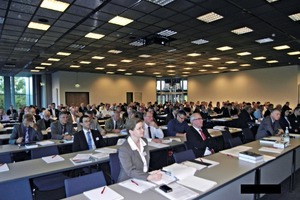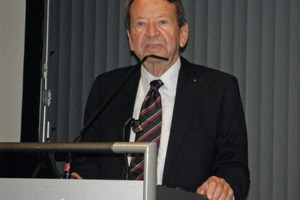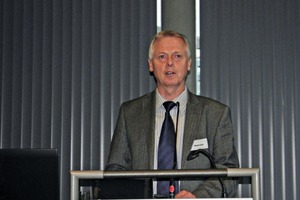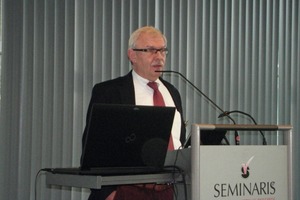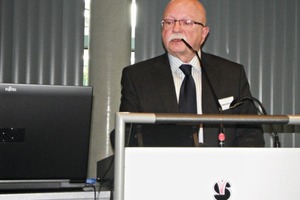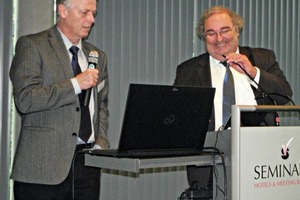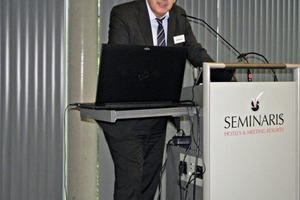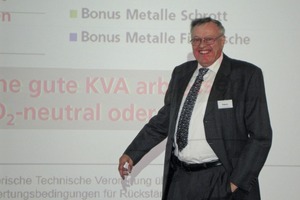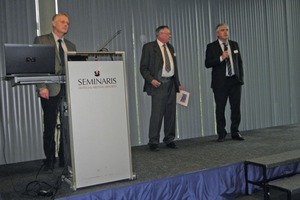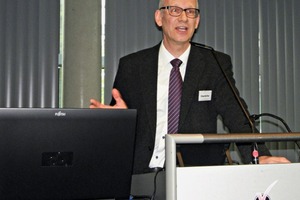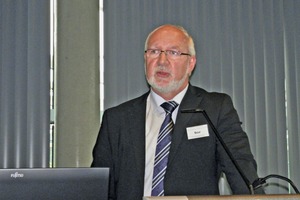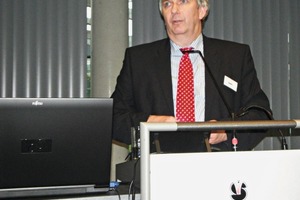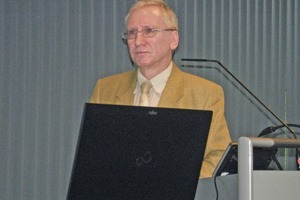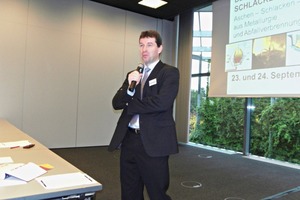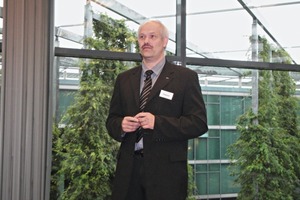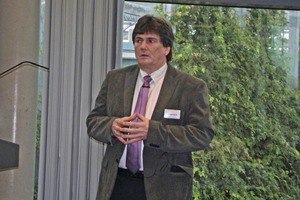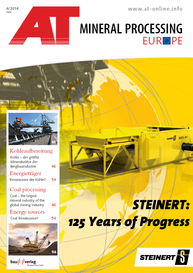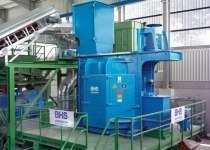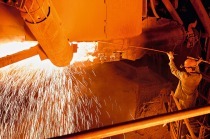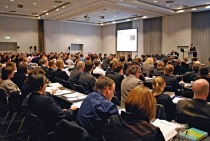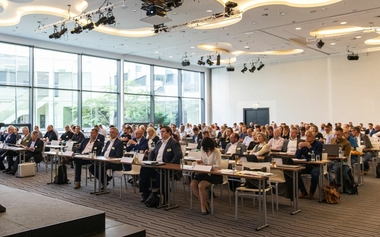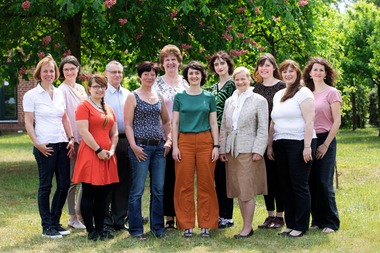Recycling potential of ashes, slags and dusts from metallurgy and refuse incineration
The Slag Conference, the third of its kind, which took place in Berlin on 23 and 24 October 2013 in Berlin, was met with great response by the 270 participants from industry, scientific institutions and authorities from home and abroad. The conference was organized by the publishing house TK Verlag Nietwerder-Neuruppin. Prof. Dr.-Ing. habil. Dr. h.c. Karl J. Thomé-Kozmiensky and Dr.-Ing. Stephanie Thiel from vivis Consult GmbH were responsible for the program coordination. A well-balanced and varied program with renowned and competent lecturers, who presented the latest findings from their special fields, was offered to the guests.
The master regulation – a tough job
The master regulation (Master V) covering groundwater, substitute building materials and soil protection was discussed during the plenary session in the morning of the first conference day. It is to regulate the handling of mineral waste, i.e. also ashes from refuse incineration and slags from metallurgical processes. Already in his inaugural address Prof. Thomé-Kozmiensky had expressed his hope that finally a law will be presented by the new Federal Government after almost 10 years of controversial discussions, which can be accepted by all those concerned. Prof. Thomé-Kozmiensky very critically examined the many tests to produce a usable slag from waste by means of melting processes. “Why at all incineration has to be replaced by the pyrolysis?” the lecturer asked. He was supported by Prof. Dr.-Ing. Hermann Wotruba from the RWTH Aachen University: “Already the Romans processed slag 2000 years ago, and it worked well!”
The situation in Germany
The handling of mineral waste is rather different in the individual federal states of Germany. The under-secretary Hans-Josef Düwel from the Düsseldorf-based ministry of climate protection, environment, agriculture and consumer protection of North Rhine-Westphalia described the situation in this federal state. About 120 million tons of mineral raw materials are used in North Rhine-Westphalia every year. About 8 to 9 % of the primary building materials are substituted by recycled building materials. Further 9 % are replaced by mineral waste. Based on the legal regulations for groundwater, substitute building materials and soil, the lecturer underlined the difficulties the cover them by Master V. However, it would be disastrous if the regulation failed. The consequence would be different regulations in the states, and irregularity would be inevitable in Germany. “A quick agreement regarding Master V is urgently required. It is needed both by the administration and economy!” was his appeal.
Dr.-Ing. Jörg Demmich from the Iphofen-based Knauf Gips KG also described a lot of shortcomings. He pointed out that the development to become a recycling society has been legally established for the entire EU. From 2020 waste will be managed as a resource at the latest. The regulations for substitute building materials (EBV) and groundwater (GrwV) as well as the federal soil protection regulation (BBodSchV) not only play a decisive role for the utilization of mineral raw materials, but they also have to be interlocked properly, adjusted and considered as a whole according to the demand of the industry. The items criticized refer to all the above regulations that need various changes and optimizations. In particular the BbodSchV must be revised comprehensively. For instance, the planned restrictive test values based on the values of the GrwV would lead to the consequence that the recultivation of quarries and other excavations will hardly be possible and that a backfilling with up to 70 million tons of recycling material will be eliminated. All in all the economy appeals to the regulatory authorities to issue regulations that will ensure also for the future the high utilization quota of mineral waste achieved in Germany so far.
Dipl.-Ing. Christian Dähn, head of department of the Augsburg-based Bavarian Regional Office for the Environment, described the state of affairs and the prospects as regards the “Use of substitute building materials in Bavaria”. Though also in Bavaria considerable amounts of mineral waste are yielded (about 41.1 million t in 2010), the majority of which could be used, recycling building materials are in a difficult position in this state rich in stones. A high processing expenditure is needed for quality assurance. In technical buildings only reinforced concrete is allowed. Even more difficult is the situation concerning the utilization of ashes and slags. In 2011 there were 532 million tons of raw ashes from refuse incineration in Bavaria of which 54 000 t of metals were recovered. 141 000 t were eliminated (deposited) and 437 000 t were used, almost exclusively in the construction of garbage dumps. Recycling building materials, which have to be built in safely, are hardly ever taken into account even for suitable buildings. As regards Master V, above all, Bavaria has its doubts that the legalisation of the values of the thresholds for insignificance would lead to unnecessary restrictions (e.g. vanadium, sulphate). Furthermore, turning away from the proven shaking eluates (water to solid ratio) of 10:1 has not been sufficiently justified, and the derivation of the material values is questioned. “Nevertheless, we hope that agreeable solutions will be found”, said the lecturer.
The situation in Austria and Switzerland
The following lectures showed that they also deal with legal regulations for the utilization of mineral waste in Germany’s neighbouring countries and that also there are difficulties.
Prof. Dr. Wilhelm Bergthaler, Johannes Kepler University Linz/Austria, presented the draft of the Austrian recycling building material regulation and particularly dealt with the conditions of utilization of residues from the metal industry, refuse incineration plants and power plants. Both the building materials and landfill regulations aimed at failed so far. Only an exemption from taxation for the use and storage of steel mill slags for building purposes has been passed. Also in Austria there are points at issue, above all in the public discussion, as regards the properties and valuable materials of waste (e.g. is it permissible to use steel mill slag for buildings). Prof. Bergthaler lamented that there is no sufficient specific technical discussion. There are rather discussions of legal and ecological subtleties.
The focus of the lecture of Dr. Hans-Peter Fahrni, formerly Federal Environmental Office, Switzerland, was on the Swiss Technical Regulation for Waste (TVA) regarding the conditions of utilization of residues from the metal industry, refuse incineration plants and power plants. The TVA, which has been valid since 1991, is expecting a total revision due to changed general conditions and targets (e.g. utilization of resources), which will lead to a hearing. The result will be the new TVA 2015. It is a special feature of Switzerland that neither blast furnaces nor smelting plants are operated. There are only two electric steel plants. There 20 000 t of steel mill dust with a content of Zn of up to 30 % are yielded every year. The electric furnace slag produced as by-product meets most of the requirements of the TVA. In this connection no changes are expected due to the revision of the TVA. Furthermore, stable residues (ashes) and slags suitable for landfilling are generated during the power generation in the 30 refuse incineration plants, from which metals can be recovered (wet and dry process). Slags from refuse incineration are not used for buildings in Switzerland since there are sufficient primary building materials. They rather established a foundation, the so-called ZAR (centre for sustainable waste and resource utilization). This foundation set up a first plant with a simple technology to recover metals from refuse incineration slag.
Analysis and utilization
of slags and ashes
The seven lectures on this topic dealt with both economic and technical problems. Dr. Michael Oberdörfer from the Regional Office for the Environment and Consumer Protection of North Rhine-Westphalia reported on “Basic data and evaluation of slag analyses” and Dr.-Ing. Michael Heußen from the Meitingen-based Lech-Stahlwerke GmbH lectured on the “Resource management for electric steel plants”. Dr. Ulrich Stock from the Potsdam-based Brandenburg Environmental Office talked about “Certified coal fly ash in the area of conflict between building product and waste law”. Prof. Dr.-Ing. Rüdiger Deike from the Duisburg/Essen University described the “Recycling potentials of metals in residues of the refuse incineration”.
The cement plant in Rüdersdorf with an annual production of 2 million tons is the largest of its kind in Germany. Dipl.-Ing. Peter Scur, senior manager – environmental protection, CEMEX Deutschland AG, Rüdersdorf, explained the demands on the used mineral secondary raw materials. A considerable portion of the most different secondary raw materials (e.g. ashes, slags, rolling scale, pyrite cinder, fibre residues, bleaching clay, foundry sands) is used in the German cement industry. Prerequisite for their use is a sufficient amount, on the one hand, to ensure a continuous supply. The lecturer showed other important contributory effects and the possible impacts of these materials on the emissions and product quality. It goes without saying that the substitution rate, which today amounts to close to 5 % (2 million t) for the clinker production, will further grow if the idea of the recycling management and process engineering will be developed further.
First results of an r³ research project for the optimization of metal recovery from grate ashes of refuse incineration plants were presented by Prof. Dr. rer. Nat. Franz Simon from the Berlin-based Federal Office of Material Research and Testing. About 90 % of the grate ashes are mineral components. Their harmful substances make it difficult to use them as substitute building materials. First a survey was given on the ash processing methods carried out and possible in principle aiming at recovering metal. The metal yield can clearly be increased by means of the impact comminution. This is due to the removal of the oxide layers, i.e. ductile metals are deformed while the brittle minerals are flaking off. The yield can further be increased by including the fines fraction < 4-5 mm, in which the metals exist both freely and chemically bonded. Above all, this is related to copper compounds, the concentrations of which in this fraction are nearly those of ores. However, subsequent separation processes like flotation and density sorting or biotechnical processes are not very promising without upstream processing stages. It still has to be checked how many treatment steps are required to be economical.
Despite all efforts to process waste from incineration plants to get valuable materials, there will always be a portion that has to be deposited. In his lecture “Technology, capacities and development of prices of the underground disposal in Germany” Dr. rer. nat. Georg Rottlaender from the Krefeld-based C.C. Umwelt AG reported on the possibilities of the underground backfilling at the end of the first conference day. His focus was not on the geological and technical prerequisites, but on the sales aspects in step with practice.
The second day of the conference was subdivided into two sections dealing with the residues from the incineration of waste and biomasses, on the one hand, and with by-products from metallurgy, on the other hand.
Residues from the incineration of waste and biomasses
Seven lectures alone dealt with slags and ashes as the essential portion of the waste from incineration plants. The recovery of metals from both wet and dry refuse incineration slag was discussed (wet discharge: Stefan Eberhard, DHZ AG Lufingen/CH; dry discharge: Dr. Edmund Fleck, Martin GmbH für Umwelt und Energietechnik, Munich).
The lecture of Dipl.-Ing. Christian Fuchs, LAB GmbH Stuttgart, focussed on the recovery of non-ferrous metals from slags. Due to innovative technologies they succeed in recovering non-ferrous metals even of the fractions < 2 mm up to < 1 mm. Thus, the entire value chain is used. Dipl.-Ing. Boris Breitenstein, Clausthal Technical University, presented a process to recover metals dissipatively distributed – the so-called three-stage ReNe process (dry mechanical, wet mechanical and wet chemical stage). The lectures of Dr.-Ing. Ralf Koralewska, Martin GmbH für Umwelt und Energietechnik, Munich, and Dipl.-Ing. Gerald Fraissler, ANDRITZ Energy & Environment GmbH, Raaba, dealt with the important topic of inerting ashes and slags for landfilling or the use in road construction. Finally, three other lectures dealt with the dust generated during incineration. On the one hand, the recovery of metals in general was of interest (Prof. Dr. Mario Mocker, Fraunhofer Institut UMSICHT Sulzback-Rosenberg). On the other hand, the lectures dealt with the recovery of zinc (Dr. Stefan Schlumberger, BSH Umweltservice AG, Sursee/CH) and the recycling of all reaction products from waste gas cleaning (Dr.-Ing. Thomas Bauer, Solvay Chemicals GmbH, Rheinberg).
By-products from metallurgy
These lectures dealt with many processes and materials to recover valuable products. About 14 million tons of slags from the iron and steel production (about 8 million t from blast furnaces and about 4 million t from electric furnaces) are yielded in Germany every year. The portion of slags from the smelting of non-ferrous metals is essentially smaller, but also considerable. The metal portions contained in this waste must be recovered.
Non-ferrous metals
The lecture of Prof. Dr.-Ing. Bernd Fried-rich, RWTH Aachen University, dealt with the recovery of copper and cobalt from slags of the non-ferrous metallurgy. In his contribution he focussed on the pyrometallurgical processes (thermochemical reduction of the oxidic valuable components). The lecturer showed with two case studies that many parameters and criteria influence the selection of the most appropriate process. For example, the content of Cu in the residues could be reduced from 0.7 to 1.3 % down to 0.4 % by means of optimization and depending on the original content of the slag. It is hardly possible to further reduce the residual content of Cu due to the enormous smallness of the Cu droplets and the long duration of coagulation that would be necessary. University professor Dr. mont. Helmut Antrekowitsch, Montanuniversität Leoben/Austria, showed that it is also very captivating to deal with residues from the Al secondary industry. For the time being, almost all potential Al secondary raw materials, such as dusts, skimmings, salt slags, furnace linings, but also Al composite materials, get to the landfill in Austria. The great affinity of Al to nobler metals is a disadvantage. The more ignoble a metal is, the more the recycling process differs from the primary extraction of the metal. Though all Al residues are considered hazardous and cause high landfill costs, the costs of processing are often even higher. But also Austria will not get around recycling in the future. The lecturer described very impressively the prerequisites to be crated for it.
Dipl.-Ing. Alois Unger, Montanuniversität Leoben, dealt with the treatment of slags from the lead metallurgy by means of investigations in laboratories and pilot plants. He showed that a recovery of the lead is possible. The residual content in the processed slag amounts to 0.4 %.
Iron and steel
The range of these lectures comprised the technical and economical analysis and evaluation of the recycling of iron mill slags (graduated commercial engineer Christoph Meyer, Brunswick Technical University) via the manufacture of high-quality building materials from steel mill slags with simultaneous metal recovery (Dr.-Ing. Andreas Jungmann, CALA Aufbereitungs-technik GmbH & Co. KG Aachen) up to the processing of special steel slags (Dipl.-Chem. Dietmar Guldan, BHS Sonthofen GmbH, Sonthofen). Just the last lecture was a good example to show how it is possible to prepare process-engineering peculiarities so as to take into account the specific properties of the material to be processed. It is possible to achieve a very good depletion of the metals and a very good comminution of the slag by means of the centrifugal rotor crusher and the rotor impact mill from BHS, In this case they can make use of a simultaneously occurring magnetizing effect for metal separation. However, this is possible only from rotor speeds of > 55 m/s. The tests in the pilot plant resulted in a process diagram and the design parameters for the users.
Final remarks
The Berlin Slag Conference showed the complexity of the recycling possibilities for waste and by-products from refuse incineration and metallurgy. Increasing prices as well as leaner and leaner ores show also in this field of economy that our industrial society cannot do without recycling due to this pressure and with the aim of an independence of raw materials as high as possible. Even if the opinion was expressed that we have sufficient primary raw materials that will be enough fro millions of years, the energy expenditure for their extraction, which are immense already today, will increase and increase. However, we do not have the money for it (Prof. Antrekowitsch). The content of the valuable minerals is going down as regards the mineability, and the resources in the waste and by-products are becoming more and more interesting. So it was no wonder that economical and technical aspects of the utilization of the mentioned ashes and slags were in the focus of the Berlin Slag Conference. It is just the recovery of metals that makes the processing of such waste payable. The changes in price of various metals are an important criterion for a decision if a recycling is reasonable or not. The question must always be if recycling is worthwhile or if there are other sources of secondary raw materials. In addition to many special, mainly technical problems, it was this topic that was discussed, frequently also controversially. The conference offered many opportunities for this during the lectures and also in the breaks. The high discipline maintained should be praised particularly as regards times specified, which not least contributed to the success of the conference. Many thanks to the organizer and the presenters.
Most of the lectures of the conference program are included in “Aschen, Schlacken, Stäube aus Abfallverbrennung und Metallurgie” by Karl J. Thomé-Kozmiensky, TK Verlag Karl Thomé-Kozmiensky, Neuruppin 2013, ISBN 978-3-935317-99-3. The next slag conference will take place in Berlin on 30 June and 01 July 2014.
Author: Dr. Brigitte Hoffmann, Consulting Abfallwirtschaft und Umweltschutz

